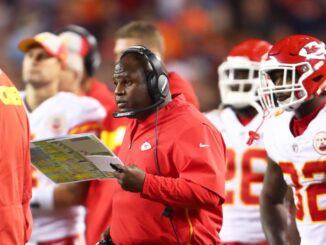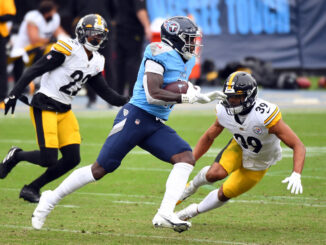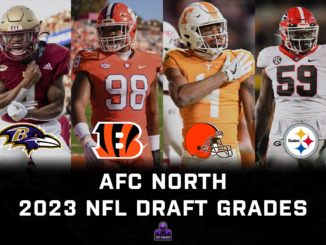
At what point do we start to reconsider some of the narratives we talked ourselves into this offseason? Two noteworthy storylines over the offseason concerned the Bengals’ revamped offensive line and the Cowboys’ defensive regression. If the opening couple of weeks are anything to go by, both of those theories were wrong.
The two teams flipped things on their head in Week 2. The Cowboys’ defensive front looked incredible and completely suffocated Joe Burrow and the Bengals’ passing game. On the other side, Cincinnati’s offensive line looked as porous as it had last year when it cost them the Super Bowl.
So how exactly did that happen? What was it that the Cowboys did to the Bengals that caused them problems time and time again? Let’s dive into the film and find out.
Simulated pressure
Before we can talk about the Cowboys’ game plan against the Bengals, it is worth providing a quick explanation of simulated pressure. Simulated pressures aren’t anything new, but they are currently taking the NFL by storm. With offenses getting so good at attacking the blitz, defenses have had to look for new ways to unsettle quarterbacks. That’s where simulated pressures come in.
In the most basic sense, a simulated pressure involves bringing a non-traditional rusher (a linebacker or defensive back) in exchange for dropping a traditional rusher (defensive lineman). There are plenty of benefits to simulated pressures. For starters, they are considered “safe”, with defenses getting the benefits of a blitz whilst still devoting seven defenders to coverage.
They also create wasted blockers for the offense. The pass protection unit has to respect the possibility of the blitz. More often than not, they will have to default to man-on-man protections. When the would-be rushers drop back, this will leave one or more blocker without anyone to block.
The Double Mug
The Cowboys employed a number of different tactics to terrorise the Bengals’ offensive line, but none of them were as effective as their use of the “Double Mug”. No matter how many times the Cowboys ran it, the Bengals just could not find an answer.
The Double Mug is a pretty basic defensive front that you will find at every level of football. It involves the traditional four defensive linemen, with the two off-ball linebackers walked down towards the line of scrimmage and standing over the center.

The purpose of the Double Mug is very simple. With six men on the line of scrimmage, the offensive line have limited options in pass protection. There are generally two solutions. The first is that the offensive line does a “full slide”. This sees the offensive line sliding in the same direction, with the running back or tight end picking up the backside defender. The problem is that the backside defender is nearly always an edge rusher. Offenses try to avoid full slides as a result of this mismatch. The other solution is to “fan block”. This sees offensive linemen fanning out and the running back picking up the leftover A-gap linebacker.
What made the Cowboys’ gameplan so interesting was that they never brought all six rushers. In fact, they didn’t bring either of the mugged linebackers as a pass rusher on any of the occasions where they used this front.
Knowing that the offensive line was likely to “fan block”, they could drop the two linebackers safe in the knowledge that at least one of their edge rushers would get a one-on-one matchup. More often than not that meant Micah Parsons against Bengals right tackle La’El Collins.
This play at the start of the second quarter was the first time they ran the Double Mug. The confusion it causes is evident, and the result is even better than Dan Quinn could have expected. The Cowboys put their two best pass rushers to the same side, with Demarcus Lawrence (#90) taking up both the right guard and right tackle. Notice how the center is left completely wasted. This situation leaves Parsons with a free rush at the quarterback. Joe Burrow is forced to get the ball out early, leading to an incompletion and the end of the drive.
The Cowboys went back to the Double Mug just before the half. This time they added some extra wrinkles to keep the Bengals guessing. This time they have Demarcus Lawrence in a two-point stance off the line of scrimmage. The Bengals have to communicate this pass protection properly to ensure that Lawrence is picked up, despite looking like a second level defender. They also add stunts on both sides of the rush. On both sides the de facto tackles plough forward, with the edge rushers looping around to collapse the inside of the pocket. It has the desired result, with Burrow taken down for a sack and the drive ending.
It is worth noting that the Cowboys ran this play four times against the Bengals. Each time, the two off-ball linebackers dropped back to cover the short areas of the field to prevent quick passes from Burrow. They were also on hand to stop Burrow whenever he looked to scramble. Every time they ran this play it ended the Bengals’ drive.
Widening the front
One of the other ways that the Cowboys caused havoc was widening their defensive front. Once again, this is not a particularly revolutionary tactic. It just happens to be the kind of thing that works to perfection against the Bengals.
There are various reasons that defenses will look to spread out their front. The main one is the fact that it prevents the offensive line from executing double teams. This play proves that point perfectly. The Cowboys are in a four-man front, but just look how wide the two defensive tackles are! Both are aligned as 3-techs, with an outside shade on the guard. This means that they are too far away for the center to help with double teams, leaving each guard one-on-one. The two offensive tackles are in the same position and the Cowboys get to Burrow and force the fumble.
This next play is an even more exotic version of the same thing and Dan Quinn adds some simulated pressure for good measure. The two defensive linemen to the left side are following the same principles as the previous play. On the right side there are four defenders bunched over the right side of the offensive line.
In the end, three of that group drop back into coverage. On the left-hand side, Quinn sends the slot corner as an additional rusher. Burrow does get the completion and first down this time, but once again the Cowboys are forcing the Bengals to live in quick game and preventing any deeper routes from having the time to develop.
Scheming up Micah Parsons
It’s no secret that Micah Parsons is one of the game’s brightest defensive talents. Last season’s Defensive Rookie of the Year is showing that his 2021 tape was no fluke and has already got off to a hot start this season. You can guarantee that neutralising him will be at the heart of any opposing offensive coordinator’s game plan.
This means that Dan Quinn needs to get a little more creative with how he uses Parsons. With the athletic ability and genuine positional versatility that he offers it isn’t difficult to see how that can be done. He showed as much this week.
This play perfectly encapsulates how Quinn schemes up easy wins for his star pass rusher. The Cowboys are aligned in an Overload front. This means that three of the four defensive linemen are to one side of the offensive line, leaving Parsons alone on the other side. That leaves the Bengals’ right guard and right tackle to handle Parsons. In theory that should be simple, but in reality it is anything but.
For starters, look where Parsons is lined up. He is playing from a wide-9 alignment, which is as far out as you will get for a defensive lineman. This makes it almost impossible for the right guard to help with the double team thanks to the sheer amount of ground he has to cover. Quinn then makes extra sure that Parsons gets a true one-on-one matchup by bringing Dorance Armstrong (#92) over the right guard. This forces the right guard to account for the potential pass rush from Armstrong and prevents the double team.
The Cowboys ran almost the exact same play later on in the third quarter. Once again you can see Armstrong shift over to the right guard. This time you actually see the right guard point to let his teammates know he will take Armstrong. Once again, Armstrong doesn’t rush, and Parsons gets the one-on-one. The Cowboys add a stunt into the mix, with Parsons forcing Burrow off his spot and once again ending the drive.
The Cowboys’ game plan is no doubt one that other teams will look to replicate in the coming weeks. If the Bengals are to have any chance of getting their offense moving again, they need to find answers to these sorts of tactics. If they don’t, it could be a long season for all involved.


